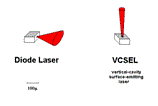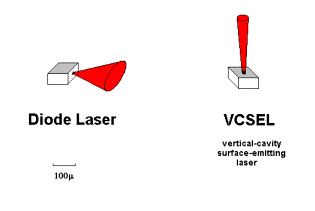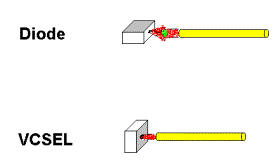Comparing Laser Types - VCSELs vs Fabry-Perot Diode Lasers

The basic design of a diode laser used in telecommunications has been around for a long time. It is really just a solid-state laser diffused into a semiconductor wafer with a size of a few hundred microns (a few tenths of a millimeter) or not much larger than a grain of salt! The cavity is basically a LED diffused into the wafer parallel to the surface of the wafer. The wafer must be cleaved at the ends of the cavity and coated as mirrors to create the laser. The mirrors on the end of the cavity are different; one being about 95% reflective, becoming the back facet, the other 95% transparent, allowing the light to escape. (The name Fabry-Perot refers to the mirrored surfaces on the ends, similar to a Fabry-Perot interferometer.)
The diode laser emits light out the side of the chip in a oval pattern.The wavelength can be set by the semiconductor processing, with devices available at 630-650 nm used in laser pointers and visual fault locators for fiber optics, 790 nm used in CD players, 850, 1310 and 1550 nm used for fiber optic transmission systems (with some 1625 coming online in the "L band" for DWDM), 980 and 1480 nm for pump lasers in fiber amplifiers, plus numerous other wavelengths for other uses. These devices tend to be fickle in operation, with great care required to keep them from "blowing up." In a normal fiber optic package, you will find a back facet detector just to stabilize them in operation. Some lasers also include optical elements in the chip to stabilize the wavelength for critical applications like DWDM where the wavelength must be ultra stable.
The biggest problem with diode lasers is cost. In order to find out if a device is good, it is necessary to dice the wafer and mount the chip before it can be powered up to test. If it's good, it will be packaged for sale; if not, it's discarded. The yield of a wafer is the other key to costs and the yield may be low.

For years, researchers have been working on creating a laser that works like a LED, emitting light up out of the wafer, perpendicular to the surface. It took years, but the VCSEL (Vertical Cavity Surface-Emitting Laser) was finally perfected. Instead of coated mirrors on the cavity, it uses epitaxial layers grown on the wafer to create mirrors on the surface with a LED sandwiched in between. These epitaxial layers can even create lenses to focus the light into a tight cone, perfect for coupling to fibers.
But the biggest advantage of the VCSEL is in testing. A completed wafer can be tested in a wafer probe machine, where each device is contacted by microscopic electrical probes and current applied. If it's good, it can be seen on a camera and measured. Thus good devices can be detected before the wafer is diced and bad ones marked automatically for discarding. This means that a VCSEL does not have to be diced and mounted in order to be tested, a major savings in cost.
The other cost savings with VCSELs comes in coupling to fibers. The tight beam couples easily to fiber without optics, while the divergent beam of the diode laser requires focusing optics. Also, the VCSEL does not require a back facet monitor like a diode laser; it can be driven like a LED, but at much higher power levels with a much lower drive current.

VCSELs have everything going for them. Simplicity, high power at low current drive, ease of coupling, good spectral characteristics, high bandwidth (~ 5 GHZ now) and LOW COST! Why don't we use them for all fiber optic communications systems? They simply are not yet available at the proper wavelengths. 850 nm is now readily available, but the first 1310 nm devices are just being made in labs. It will take a year or more before they become readily available Gigabit Ethernet and Fibre Channel already use 850 VCSELs for their low cost version.
You can bet that the 1310 devices will be incorporated in every system appropriate as soon as possible to take advantage of the lower cost ( we estimate about 25% as much as a F-P laser.) 1310 VCSELs could be the key to cost justification of fiber to the home (FTTH).
Fotec offers test sources using both Fabry-Perot diode lasers and VCSELs to closely simulate the actual system source for more accurate testing.
For more information on diode lasers, see Sam Goldwasser's articles at: http://repairfaq.cis.upenn.edu/sam/laserdio.htm
Fotec,inc./Fiber U 151 Mystic Ave, Medford, MA 02155. Tel: 800-537-8254 (US & Canada) or 781-396-6155; Fax: 781-396-6395; e-mail: info@cableu.net
Gigabit Ethernet
Gigabit Ethernet or GbE, as the name says, is Ethernet scaled up to gigabit speeds, providing a migration path from Ethernet at 10 Mb/s to Fast Ethernet at 100 Mb/s and then on to gigabit speeds for network backbones. It has a data rate of 1 gigabit per second (Gb/s, a billion bits per second) and a baud rate of 1.250 Gb/s including the data encoding.
These speeds require laser transmitters, since LEDs run out of steam at a few hundred Mb/s (millions of bits/second). Two fiber optic standards are approved: 1000BASE-SX for short wavelength lasers over multimode fiber and 1000BASE-LX for long wavelength lasers over multimode or singlemode fiber. The short wavelength standard will typically be met with a 850 nm VCSEL (vertical cavity surface emitting laser), a new type of device that offers high performance and very low cost. A CD laser may also be used. Long wavelength lasers will be standard 1300 nm singlemode transmitters.
